Quick Question: Is Bone Broth Thick Or Thin?
Bone broth tends to be thinner than traditional soups due to its focus on simmering bones and connective tissues. While it’s more gelatinous than water due to collagen extraction, it’s not as thick as some soups. The extended cooking process extracts nutrients and imparts a savory flavor to the liquid.
Ready to meet your new favorite ingredient? Bone broth recipe has been enjoyed for thousands of years as a drink and a base for soups and stews.
The benefits of bone broth go beyond its cooking convenience. The bones are packed with nutrients and goodness, slowly infusing the broth over a long simmer.
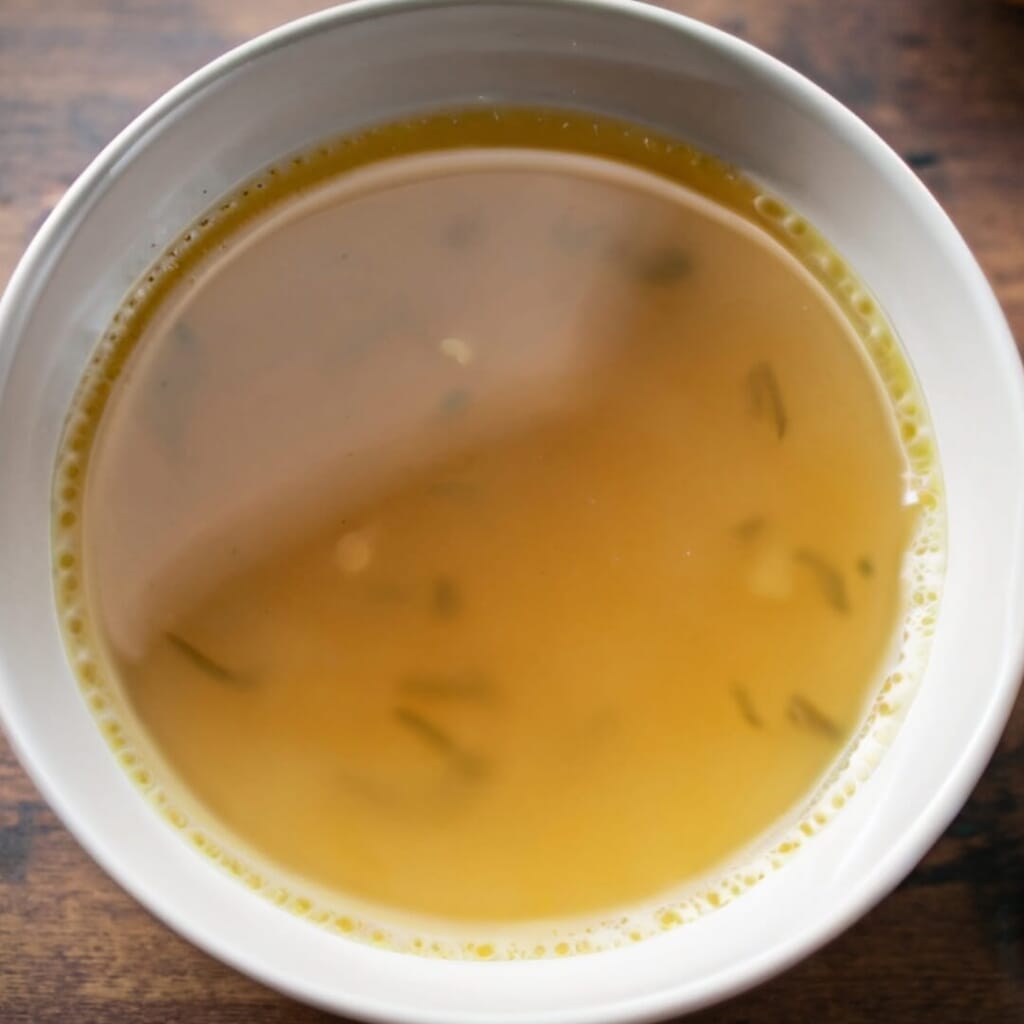
Bone broth has been linked to an improved immune system and can aid weight loss.
While bone broth can have many benefits, it’s important to enjoy it as part of a healthy diet! This guide will explore why you should enjoy bone broth and how to make it at home.
What Is Bone Broth?
Bone broth offers numerous health benefits. It’s rich in minerals that strengthen bones. The collagen content promotes healthy skin and joint function. Amino acids like glycine and proline aid muscle recovery and gut health.
Regular consumption can improve digestion, reduce inflammation, and boost the immune system. Additionally, it provides essential nutrients, acting as a natural multivitamin. Overall, bone broth is a nourishing elixir for overall wellness.
History Of Bone Broth
For centuries, bone broth has been a global healing elixir. Ancient civilizations from China to Egypt recognized its curative properties. They cherished it for strengthening bones, revitalizing skin, and promoting digestion.
As an integral part of traditional medicine, it was prescribed for various ailments. From Europe’s medieval hearths to Asian herbal clinics, its reputation grew as a health tonic.
Today’s renewed interest in bone broth reflects its deep-rooted history as a potent and nourishing remedy.
Interesting Facts About The Bone Broth
- Collagen Rich: A natural source of skin’s favorite protein.
- Gut Guardian: Helps repair the gut lining and manage IBS symptoms.
- Joint Joy: Contains glucosamine and chondroitin, celebrated for joint health.
- Mineral Mine: Packed with calcium, magnesium, and phosphorus, all vital for bone strength.
- Detox Dynamo: Glycine aids liver detoxification.
- Immune Booster: A nutrient-dense broth can bolster your immune defenses.
- Mood Modulator: Amino acids may help improve mood and sleep.
- Age-old Elixir: Humans have savored its benefits for thousands of years.
- Hydration Helper: Electrolytes in the broth support hydration.
- Metabolism Magic: Can support weight loss and metabolic health.
What Makes The Bone Broth Special?
- Whole-Food Source: Natural, unprocessed nutrition powerhouse.
- Versatility: Sips like tea, enhances dishes, or stands alone as a soup.
- Time-Tested: Used in ancient healing traditions across cultures.
- Bioavailability: Nutrients are easily absorbed by the body.
- Simplicity: Made from basic, wholesome ingredients.
- Holistic Health: Targets multiple body systems simultaneously.
- Natural Gelatin: Supports digestion and gut health uniquely.
- Healing Hydration: Provides both nourishment and hydration.
- Low-Calorie Density: Nutrient-rich without being calorie-heavy.
- Connective Tissue Care: Directly nourishes joints, skin, and hair, unlike any other food.
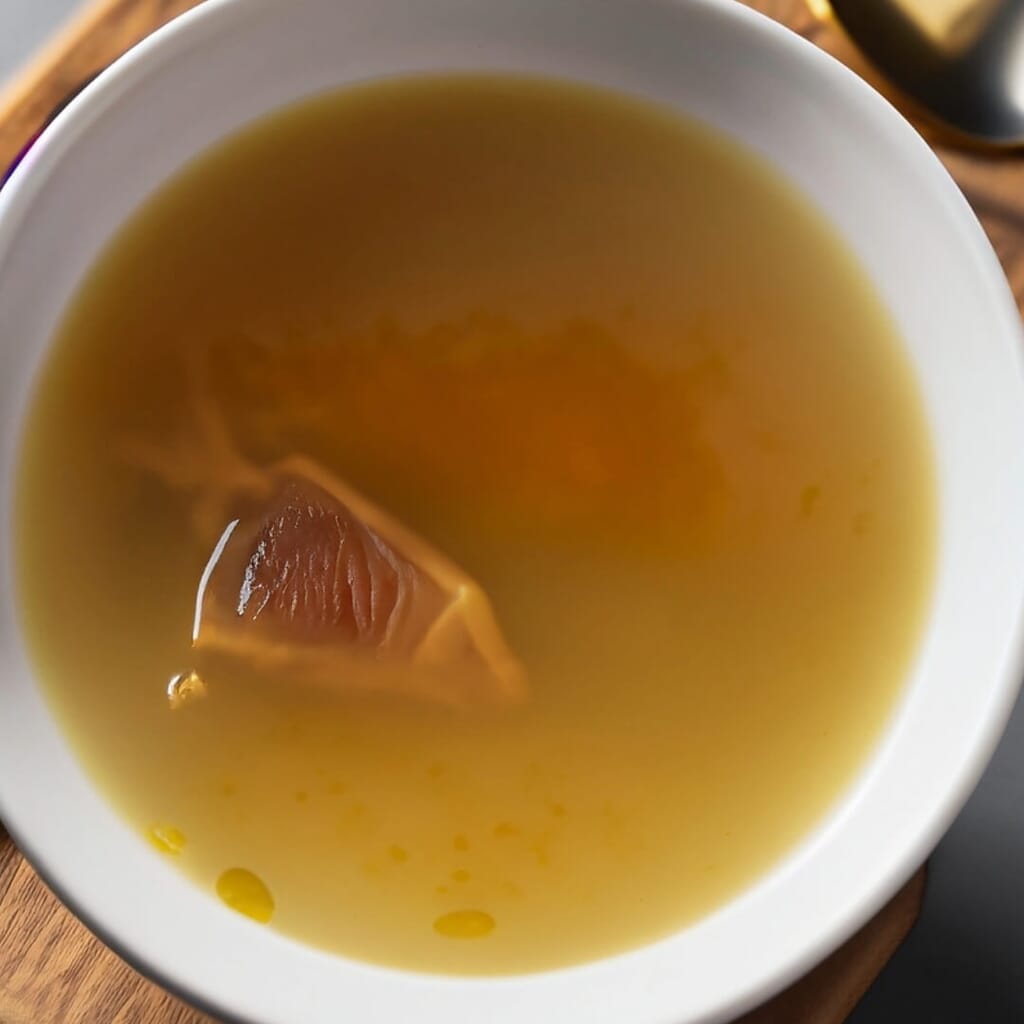
Ingredients List
| Ingredient | Quantity |
| Bones | 2 pounds |
| Water (plus more to cover) | 3 quarts |
| Apple cider vinegar | 2 tablespoons |
| Large carrot | 1 |
| Large onion | 1 |
| Salt (to taste) | As needed |
| Pepper (to taste) | As needed |
Ingredients For Bone Broth
The ingredients list for bone broth is very simple. The key is, unsurprisingly, the bones! Let’s take a look at what you need to make bone broth:
- 2 pounds of bones. If you want to up the nutritional blend of your bone broth, use a mixture of bones. Beef bones such as short ribs, oxtails, neck, and marrow bones are all good choices. You can also use pork bones and chicken bones. If you’ve enjoyed a rotisserie chicken, keep the carcass for bone broth!
- 3 quarts water plus more to cover. For the best flavor, use filtered water. However, any clean water will do.
- 2 tablespoons of apple cider vinegar. Apple cider vinegar is our preferred choice, but any vinegar will do. Just keep in mind that a different vinegar will alter the flavor slightly.
- 1 large carrot. Adds flavor and extra nutrients.
- 1 large onion. Adds flavor and extra nutrients.
- Salt and pepper, to taste. You can play around with different seasonings, such as thyme, star anise, and bay leaves. However, different seasonings will change the overall flavor of the broth. For the most versatile broth, stick to salt and pepper.
These measurements will make roughly 2 ½ quarts of bone broth, but you can scale the recipe up and down as needed.
All you need is bones, enough water to cover them, and a touch of acid and some seasoning!
Ingredient Tips
- Bones Selection: Mix marrow, knuckle, and meaty bones for depth.
- Roasting First: Roast bones before simmering for a richer flavor.
- Cold Start: Begin with cold water to extract flavors slowly.
- Vinegar Vitality: Apple cider vinegar helps leach minerals from bones.
- Skim Often: Regularly skim the surface to remove impurities.
- Fresh Veggies: Use organic carrots and onions for a pure taste.
- Herb Boost: Add parsley or thyme for an aromatic lift.
- Long Simmer: The longer you simmer, the more nutrients you extract.
- Storage Savvy: Freeze in portions for easy access.
- Season Last: Add salt and pepper at the end to control flavor.
Can You Vary The Recipe With Other Ingredients?
- Keto & Paleo: Stick to the basic recipe, but add high-fat ingredients like coconut oil or ghee for a keto boost. For Paleo, ensure all ingredients are organic and unprocessed.
- Gluten-Free: The standard bone broth recipe is naturally gluten-free. Always check the source of your vinegar to ensure no gluten cross-contamination.
- Whole30: Use compliant ingredients. Avoid additives or sweeteners.
- Vegetarian: Replace bones with a combination of hearty veggies like mushrooms, seaweed, and root vegetables. These impart a deep, umami flavor.
- Vegan: Follow the vegetarian version and add nutritional yeast for a richer taste.
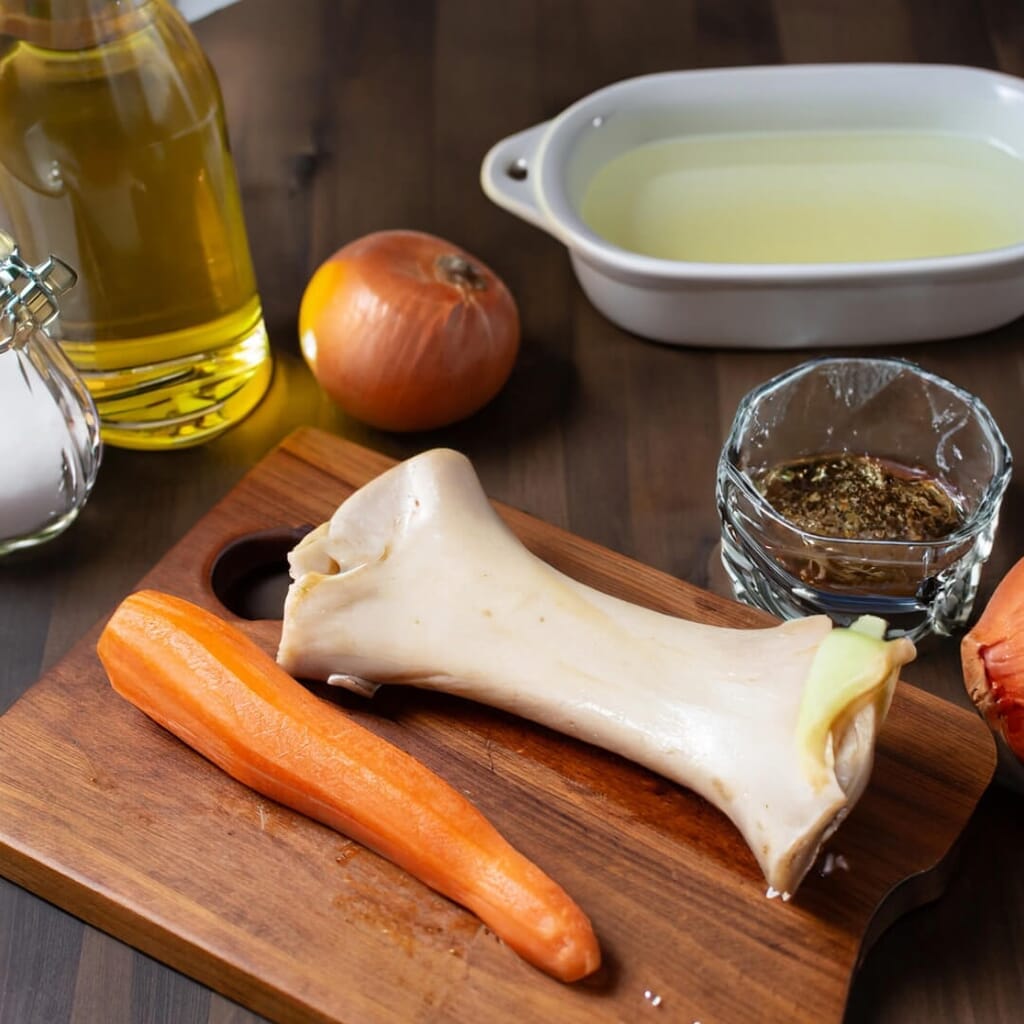
Recipe Directions
- Rinse and pat dry bones.
- Roast bones at 400°F for 30 minutes.
- Soak bones in water and vinegar in a stockpot for 30 minutes.
- Bring to a simmer, reduce heat, and simmer uncovered for 1 hour.
- Add salt pepper; cover and simmer for 24 hours.
- Add onion and carrot; simmer for another 12-24 hours.
- Cool, strain, and store or serve.
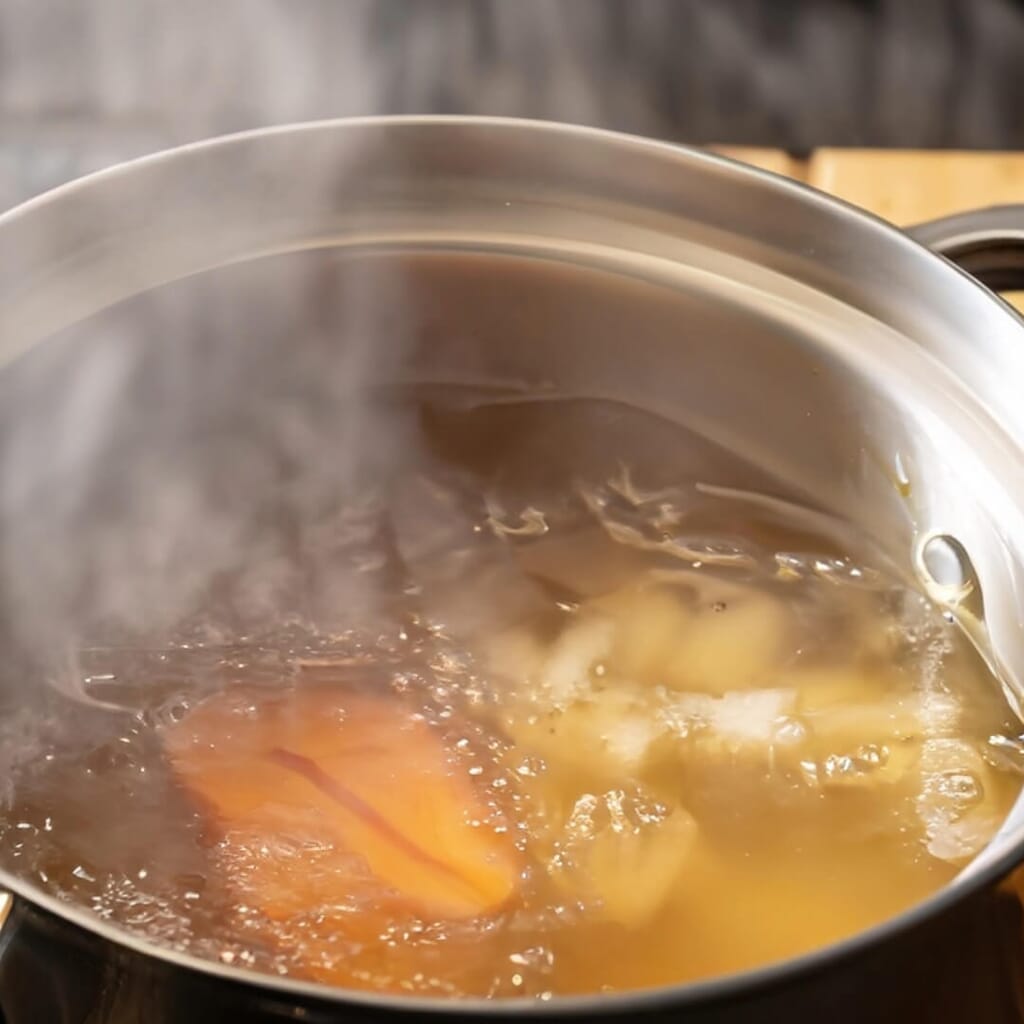
Variations, Add-Ons, And Toppings
Variations
- Poultry: Use chicken or turkey bones for a lighter, delicate flavor.
- Fish: Fish bones and heads yield a lighter broth packed with iodine.
Add-Ons
- Herbs: Thyme, rosemary, and parsley infuse aromatic undertones.
- Spices: Turmeric and ginger lend anti-inflammatory properties and warmth.
- Veggies: Leeks, celery, and mushrooms deepen the flavor profile.
Toppings
- Greens: Fresh spinach or kale wilts perfectly in a hot broth.
- Seeds & Nuts: Sprinkle chia, flaxseed, or crushed almonds for a crunchy texture.
- Oils: Drizzle olive oil or sesame oil for richness.
- Grains: Quinoa or barley can be added for a more filling broth.
Scaling The Recipe
- Proportions: Keep ingredient ratios consistent. Double the water, vinegar, and other ingredients if doubling the bones. The same applies when reducing.
- Vessel Size: Ensure your cooking vessel accommodates the increased or decreased volume. A larger pot may be needed for scaling up.
- Cooking Time: While the roasting time for bones remains constant, simmering time might vary slightly. For larger batches, ensure thorough simmering to extract maximum nutrients.
- Taste Test: As you scale, periodically taste. Sometimes, scaled recipes may need minor adjustments for seasoning.
- Storage: Anticipate larger containers for increased quantities. For reduced batches, consider smaller storage or freezing in portioned amounts.
What Is Used For Garnishing?
- Herbs: Fresh basil, cilantro, parsley, dill, and chives add color, aroma, and flavor.
- Citrus Zest: Grated lemon, lime, or orange zest imparts a vibrant, tangy touch.
- Edible Flowers: Pansies, violets, or marigolds make dishes visually appealing.
- Seeds & Nuts: Sesame seeds, crushed almonds, or toasted pine nuts give texture and richness.
- Spices: A sprinkle of paprika, sumac, or freshly cracked pepper can elevate the presentation.
- Drizzles: Olive oil, melted butter, or balsamic reduction for an added flair.
- Grated Cheese: Parmesan or pecorino can be grilled atop dishes for a savory finish.
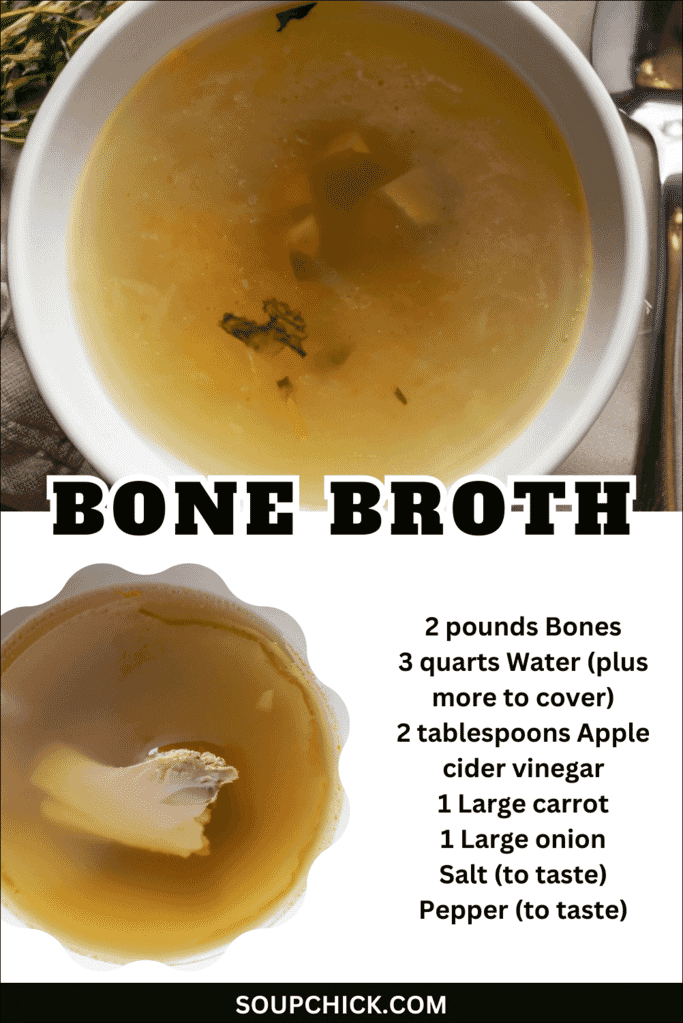
Can I Make Bone Broth In A Slow Cooker Or Instant Pot?
Slow Cooker
- This method is ideal for bone broth. Just add your ingredients to the slow cooker and set it on low. Allow it to simmer for 24-48 hours.
- The longer it cooks, the richer the flavor and nutrient content. It’s low-maintenance and ensures a steady, prolonged heat for nutrient extraction.
Instant Pot (Pressure Cooker)
- A faster method but equally effective. Place the ingredients inside, secure the lid, and set it on the “broth” or “soup” setting.
- Cook for 2-3 hours. The high pressure helps extract nutrients quickly, delivering a rich broth in a fraction of the traditional cooking time.
Can I Use Store Bought Broth, Or Should I Make My Own?
Store-Bought Broth
- Convenience: Quick and easy, especially when you’re short on time.
- Consistency: Generally offers a uniform taste and quality.
- Choices: Varieties are available, including organic, low-sodium, and specific dietary preferences.
Homemade Broth
- Control: Decide on ingredients, ensuring no unwanted additives.
- Nutrition: Typically richer in nutrients, as you can simmer longer.
- Flavor: Freshness usually delivers a deeper, more robust taste.
Can I Use Different Types Of Meat/Fish/Pasta/Vegetables For The Soup?
- Meat: Beyond typical beef bones, chicken, turkey, pork, or lamb offer unique flavors and benefits. Organ meats can also be included for added nutrients.
- Fish: Fish heads and bones, especially from oily fish like salmon, provide a broth rich in omega-3s.
- Pasta: While traditional broths don’t include pasta, adding noodles can transform it into a hearty soup. Ensure it’s cooked properly to prevent over-sogginess.
- Vegetables: The sky’s the limit! Carrots, onions, and celery are staples. However, leeks, mushrooms, tomatoes, kale, and even seaweeds can be added for varied flavors and nutrition.
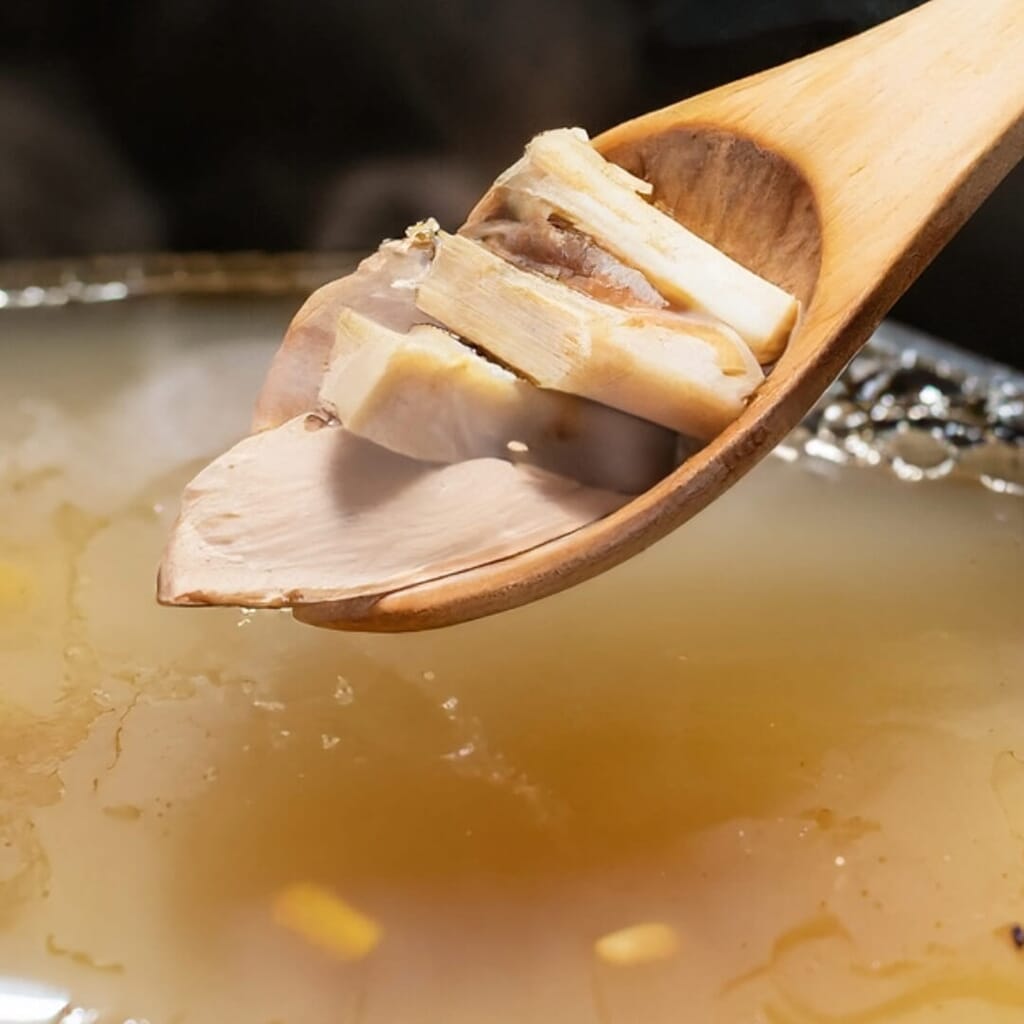
Success Tips – Tips And Tricks For Making The Soup
- Bone broth can be purchased in-store, a great way to add bone broth to your diet quickly. But the best way to enjoy bone broth is by making your own.
- Homemade bone broth is high in nutrition, low in preservatives and salt, and cost-effective.
- It’s also a great way to make leftovers from a family dinner! Use leftover rotisserie chicken as the base for a simple bone broth.
- Speak to your butcher to get your hands on high-quality bones for your broth. They can help you find the right mixture of bones and even prepare some larger bones.
- The recipe listed below is for making bone broth on the stovetop. However, you can also make it in the slow cooker!
- Once you’ve roasted your bones, cover them with water and a touch of vinegar, and bring them to a simmer with the HIGH setting.
- Simmer for 24 hours; add your onions and carrot and simmer for another 24 hours.
- There are no exact timings for making bone broth, although longer is typically better.
- If you can simmer your broth for over 24 hours, the collagen and nutrients have more chance to break down and infuse.
- However, if you only have 6 hours, you can still make a good bone broth! It just won’t have the same nutritional punch of a longer simmer.
- Bone broth is done when the liquid is golden brown, and the bones have started to fall apart. When the bones break, you know all the nutritional goodness has left them.
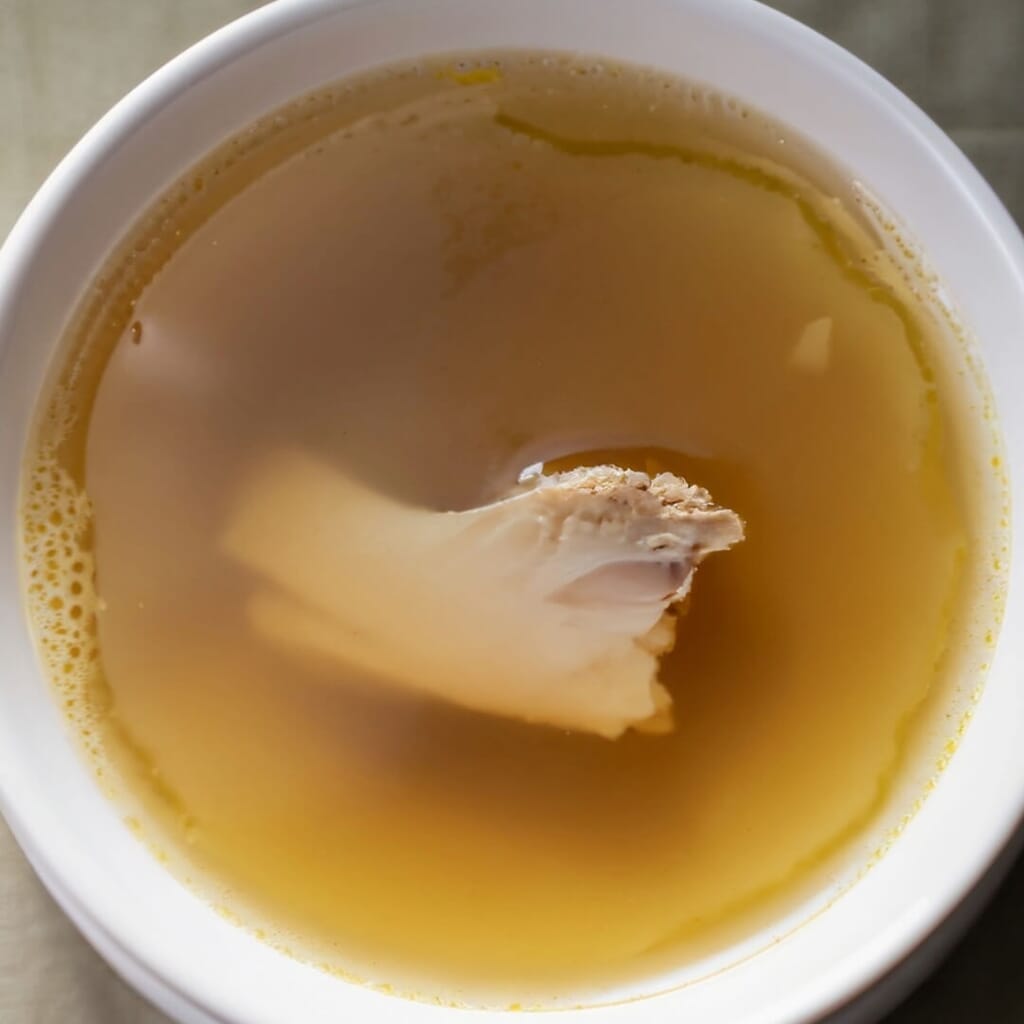
Nutritional Values
Bone broth isn’t just a culinary delight; it’s a nutritional powerhouse. This broth promotes joint health, aids digestion, and nourishes the skin with essential minerals, amino acids, and collagen. Each sip offers a holistic embrace of wellness.
What Are The Total Calories In The Soup?
The total calories in bone broth vary based on the type of bones used, the addition of vegetables or other ingredients, and the cooking time. So, a bone broth will have 80 to 100 calories per serving. Further, it may vary based on the bones you are using and how long you are boiling it.
Dietary Restrictions Of The Bone Broth
- Vegetarian/Vegan: Bone broth is off-limits, as it’s made from animal bones.
- Keto/Paleo: Perfect fit! Bone broth is low-carb and packed with proteins and fats.
- Gluten-Free: Typically safe. Ensure no gluten-containing additives or thickeners are used.
- Low-Sodium: Homemade allows control over salt. Store-bought may be high in sodium.
- Allergies: Check ingredients. Some broths might have additives or vegetables that could trigger reactions.
- Gout: High purine content in broths, especially from certain fish or meats, can be a concern.
Health Benefits Of The Bone Broth
- Bone broth is made using whole bones and a long, slow simmer. This process allows all the good things from the bones to infuse into your broth, giving you a punch of nutrients with every sip.
- Let’s take a look at some of the benefits of drinking and eating bone broth:
- Bone broth contains plenty of collagen, which can improve the health and strength of nails and hair.
- Collagen is also linked to anti-aging properties. It can help reduce the appearance of wrinkles and add bounce and elasticity to older skin.
- And one more collagen benefit — collagen can strengthen the connective tissue and the joints for easier movement even as you age.
- Bone broth is also full of amino acids. Broken down in the broth, these amino acids can be absorbed quickly, getting to work in your body.
- Amino acids can strengthen and rebuild tissues, bones, and muscles. This can help fight against osteoarthritis.
- The amino acid glutamine is found in bone broth. This can help support the intestinal barrier, making it easier to digest food and reducing stomach complaints.
- A boost in amino acids can also help the immune system, making you less likely to fall ill.
- Glycine is another amino acid found in bone broth. Glycine has been linked to better sleep, which means sipping bone broth at bedtime might help you sleep deeper and wake up refreshed.
- Bone broth contains electrolytes such as calcium, sodium, and magnesium. These can help balance your body for better function.
- Thanks to the rich blend of electrolytes, bone broth can help you get back on your feet after heavy exercise.
- Bone broth is high in proteins, which help you feel fuller for longer. This can stop you from snacking, making it easier to lose weight. Especially as bone broth has a high number of proteins compared to calories!
- If you make your bone broth with veggies (which we recommend), you’ll also get a dose of vitamins and minerals.
- These are some of the nutritional benefits of enjoying bone broth, with help from Cleveland Clinic and Medical News Today. Now, let’s explore other reasons for making bone broth part of your diet.
- Bone broth can be a quick and convenient base for soups, stews, and sauces.
- But you can also enjoy bone broth on its own! Try sipping on a cup of bone broth before bed.
- Making bone broth is a low effort but delivers high rewards. It might need a long cooking time, but the hands-on prep takes less than 15 minutes!
Nutrition Table
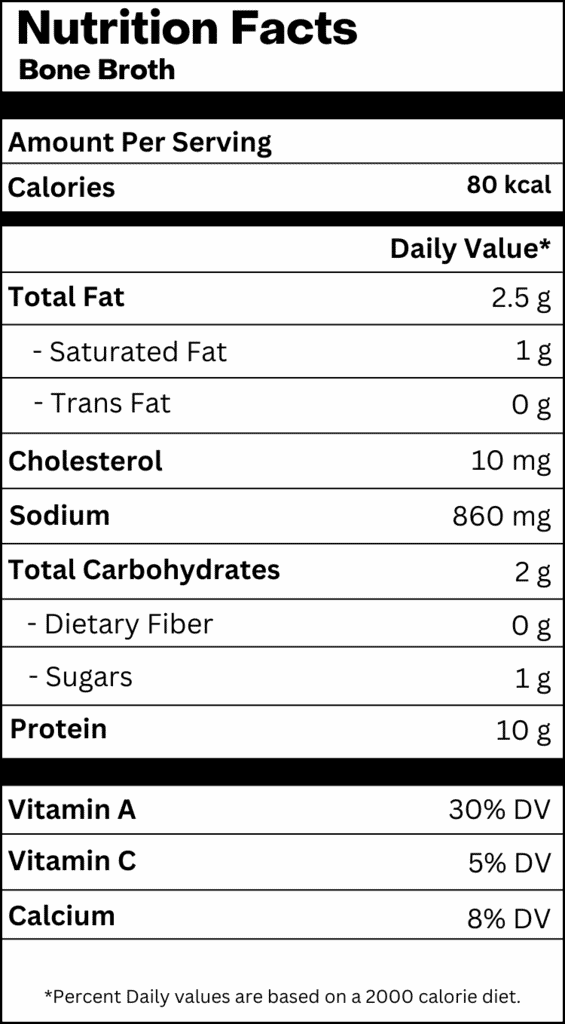
How Can I Make Bone Broth Lower In Sodium?
- Avoid Table Salt: Start by not adding any salt during cooking. You can season later if needed.
- Fresh Ingredients: Opt for fresh vegetables instead of canned or prepackaged, which may contain added salt.
- Natural Bones: Ensure bones aren’t pre-seasoned or salted. Often, grocery butchers provide pure, unaltered cuts.
- Store-bought Caution: If purchasing, select low-sodium or unsalted versions.
- Herbs & Spices: Enhance the flavor with sodium-free seasonings like bay leaves, garlic, turmeric, or thyme.
- Water Source: Ensure your tap water isn’t naturally high in sodium.
- Taste Test: If you add salt gradually, taste as you go.
How Can I Make Bone Broth Lower In Sugar?
- Avoid Sweet Vegetables: Carrots, onions, and tomatoes in excess can contribute natural sugars. Use them sparingly.
- No Additives: Ensure no sugar-containing sauces or flavorings are included.
- Check Store-bought: Many commercial broths have added sugars. Opt for unsweetened versions.
- Limit Wine Additions: If using wine for flavor, ensure it’s dry, not sweet.
- Natural Herbs: Enhance flavor with rosemary, thyme, or bay leaves instead of sugary ingredients.
- Beware of Bones: Some marinated or processed meats have sugar. Use raw, unprocessed bones.
- Read Labels: Always check ingredient lists for hidden sugars when buying components.

How To Serve The Bone Broth At Its Best?
- Heat Properly: Warm slowly on a stovetop to preserve flavors and nutrients.
- Strain Well: Ensure clarity by straining out bone fragments and vegetable particles.
- Adjust Seasonings: Do a final taste test and adjust salt or herbs as needed.
- Presentation: Use warm bowls or mugs to maintain temperature.
- Garnish: Add fresh herbs, a drizzle of olive oil, or a squeeze of lemon for an elegant touch.
- Companions: Serve with crusty bread, steamed veggies, or a side of rice.
- Consistency: If too thick, dilute with water or stock; if thin, simmer longer.
- Serve Promptly: For optimal flavor and warmth, serve immediately after reheating.
Perfect Side Dishes To Complement Bone Broth
- Crusty Bread: Absorbs the broth’s flavor and adds a textural contrast.
- Roasted Vegetables: Like carrots or potatoes, root veggies harmonize with the broth’s depth.
- Green Salad: Fresh greens with a light vinaigrette balance the richness of the broth.
- Steamed Rice: Especially jasmine or basmati, it pairs subtly with aromatic broths.
- Grilled Mushrooms: Earthy tones make them a fitting companion.
- Quinoa Salad: Offers a protein-packed, grainy texture to juxtapose the liquid broth.
- Stuffed Bell Peppers: Filled with grains or meats, they contrast heartily.
- Noodle Bowls: Thin rice noodles or soba add substance and make it a meal.
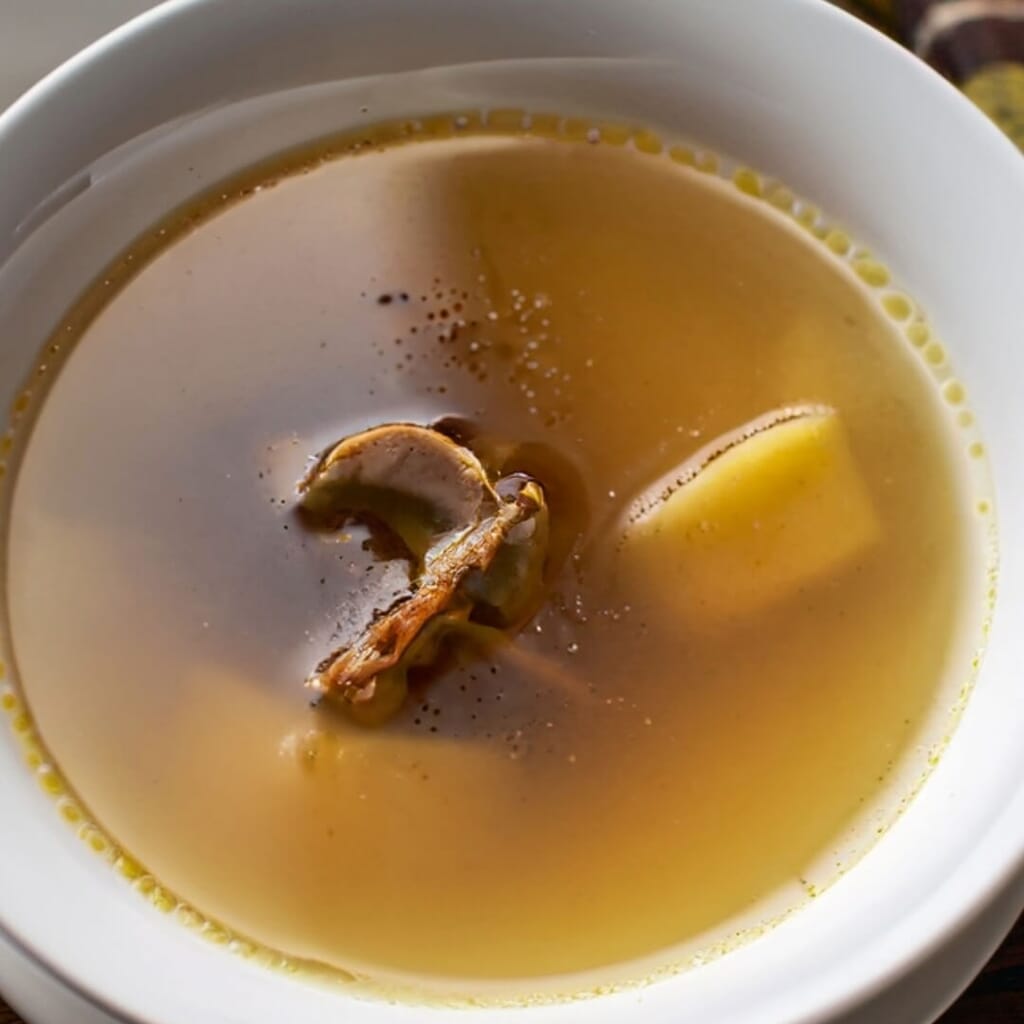
How Long Can We Store The Soup?
Homemade bone broth can be stored in the fridge or freezer. Bone broth can be stored in the refrigerator for up to 5 days. It lasts for roughly 6 months in the freezer.
We recommend making a big batch and storing your bone broth in the freezer. It’s a slow process, so a huge batch is the best way to make the most of the long simmer.
Store in small measurements so you can defrost just enough for one recipe at a time.
You can also store your bone broth in ice cube trays! Freeze your bone broth in an ice cube tray, giving you a convenient flavor boost for soups and stews.
To boost storage space in your freezer, reduce the bone broth by half using a long simmer over low heat.
Once you’ve defrosted the bone broth, add extra water to thin it out before using it. This is particularly useful if you’re using the ice cube trick!
Bone broth can also be purchased in shelf-stable cartons in stores and online. These cartons are incredibly convenient, especially if you don’t have 24 hours to simmer your broth!
We recommend storing a carton or two as they typically have a long life.
Can I Make The Soup In Advance?
Making bone broth in advance is practical and efficient. Preparing large batches ensures a steady supply for days or even months. After cooking, cool the broth to room temperature. Store in the refrigerator if using within 3-5 days.
For extended storage, freeze it. Frozen broth retains flavor and nutrients for up to 6 months. When needed, thaw and reheat. This approach saves time and allows for spontaneous meals and last-minute recipes.
How Do You Use Bone Broth?
You might wonder what to do next once you’ve packed your freezer full of bone broth!
Bone broth is a highly versatile ingredient. Once you’ve started adding it to your meals, you won’t want to stop!
Bone broth makes an excellent base for soup. It adds more flavor than water and has more nutrients than stock. If you’re making chicken soup to fight off a cold, try adding bone broth.
Bone broth is also a must-have ingredient for anyone who loves Asian cuisine. Bone broth can make pho ramen or your favorite noodle soup.
As well as soup, bone broth can be a fantastic flavor base for stews and curries.
It has a deep, warming taste that can be adapted to new seasonings, herbs, and spices. Try adding bone broth to a chili or a curry!
Any time you turn to stock or water, use bone broth instead.
But bone broth can be used as more than just an ingredient in a recipe. Bone broth can be enjoyed as a relaxing and warming drink.
Sip on a cup of bone broth before bed or during a tiring afternoon.
What Can We Do With Leftovers?
- Soups & Stews: Use as a flavorful base, enhancing richness and depth.
- Grains: Cook rice, quinoa, or barley in broth for added nutrients and taste.
- Sauces & Gravies: Deepen the flavor of your homemade sauces.
- Braising: Use the broth as a braising liquid for meats and vegetables.
- Steam Veggies: Replace water with broth for a nutrient boost.
- Smoothies: For an unconventional twist, blend with savory smoothie ingredients.
- Pasta: Cook pasta directly in the broth or use it in pasta sauces.
- Freeze: Make broth cubes for quick flavor boosts in recipes.
- Drink: Warm, season, and sip as a nutritious beverage.
- Risotto: Impart a rich taste by using broth instead of water.
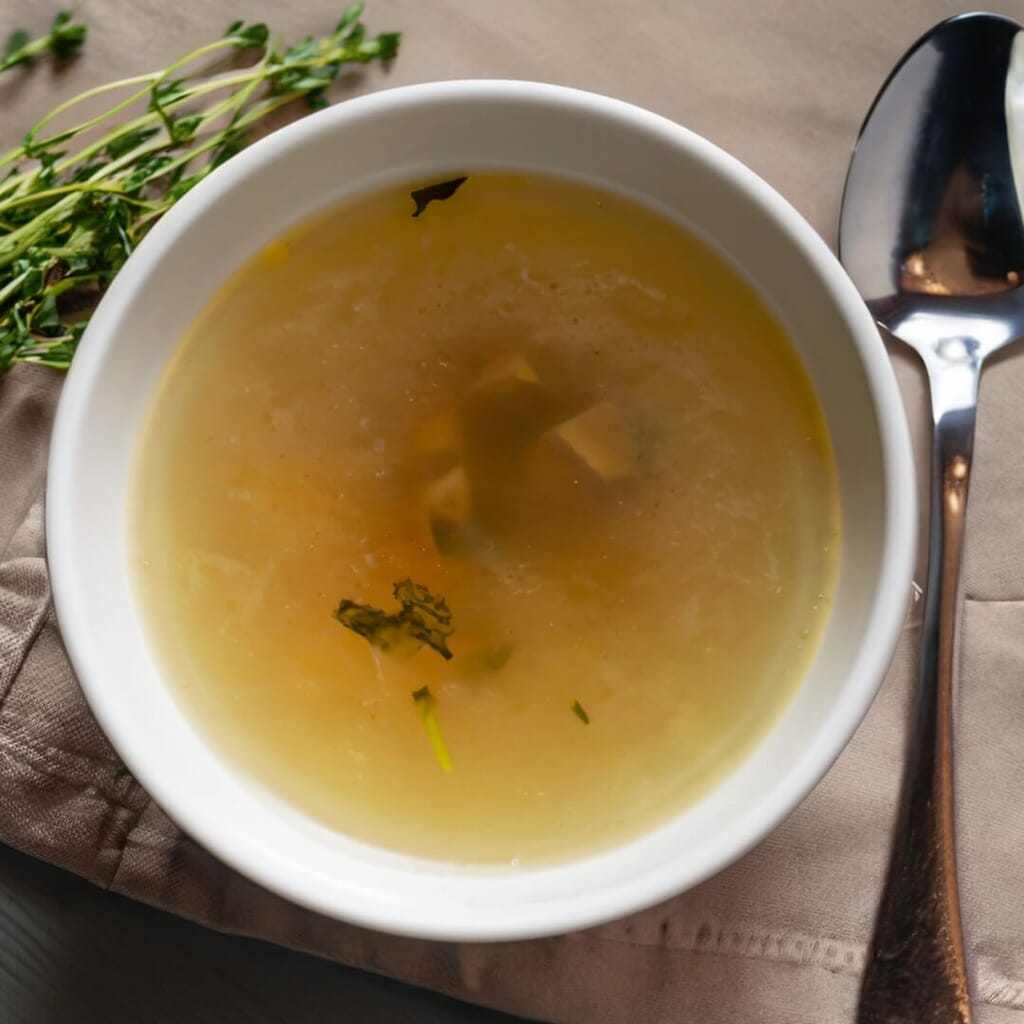
Special Tools/Equipment Needed
- Stockpot: A large, durable pot is essential. It should have a heavy bottom to distribute heat evenly.
- Slow Cooker/Instant Pot: These can simplify the process, especially for prolonged simmering.
- Roasting Pan: For roasting bones before simmering, which deepens the broth’s flavor.
- Strainer: A fine mesh strainer helps separate the liquid from the solids.
- Skimmer: Useful for removing impurities and foam from the surface during cooking.
- Ladle: To pour broth into storage containers.
- Cheesecloth: For an extra-fine strain, remove smaller particles.
- Thermometer: Ensures the broth stays at a safe temperature.
- Storage Containers: Preferably glass for refrigerating or freezing.
- Ice Cube Trays: Perfect for freezing broth in small, easily thawable portions.
Conclusion
Bone broth takes an underappreciated ingredient — bones — and transforms them into a kitchen staple.
Thanks to the high levels of proteins and amino acids, bone broth can help you lose weight, look younger, and feel better.
Bone broth is also a delicious alternative to stock. Although making bone broth might be slow, it’s easy to do with minimal hands-on work.
And because bone broth freezes well, you can make a large batch to enjoy as needed.
Frequently Asked Questions
What Recipes Can I Make With Bone Broth?
Any time you use water or stock in a recipe, try replacing it with bone broth. Bone broth can be used in soups, stews, curries, and chili. You can also use bone broth to make gravy and mashed potato in stroganoff or noodle dishes!
What Is The Bone Broth Diet?
The bone broth diet is a 21-day diet plan. During the bone broth diet, 5 days are spent eating a low-carb paleo diet. The other 2 days are fast days when followers eat nothing but bone broth.
The bone broth diet is designed as a quick way to lose weight, but it has yet to be proven effective in the long term.
Can The Broth Be Made With Frozen Bones?
Yes, frozen bones can be utilized directly without thawing. However, ensure you adjust your cooking time, especially if roasting, as they may take longer to heat through.
Is It Possible To Overcook Bone Broth?
While bone broth benefits from long cooking times, there’s a point where the bones can become overly depleted, resulting in a diluted taste. Always observe the broth’s color and flavor, ensuring it remains rich and flavorful.
Why Does My Cooled Bone Broth Have A Jelly-Like Consistency?
A gelatinous texture, when cooled, indicates a high collagen content, a sign of a well-made broth. This is a positive attribute; the broth will return to liquid upon reheating.
- How To Make Butternut Squash Soup Recipe – Easy And Delicious - February 13, 2024
- Perfect Chinese Chicken Soup Recipe – A Delightful Feast - October 3, 2023
- Easy Red Pepper Soup Recipe (Sweet-Mild Flavors) - October 3, 2023

